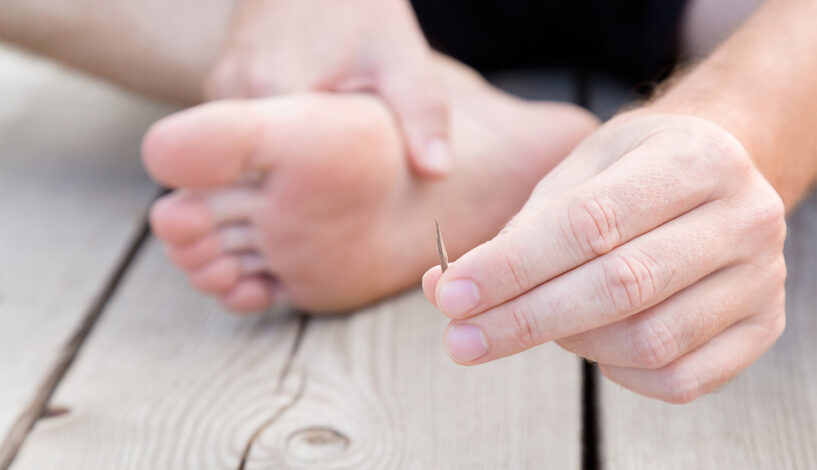
7 Effective Tips On How To Get a Splinter Out
Everyone encounters splinters — whether they get stuck in or underneath your own skin or you’re helping a friend or family member remove one. If you’re at all unsure about how to handle splinters, we’re breaking down our best tips and what you should know on the topic.
What Is a Splinter?
Splinters most commonly come from a piece of wood, but can also occur from several other materials.
You may feel it when a tiny fragment pierces the outer layer of your skin, or you may only notice something embedded in your skin later on. Splinters are very common, especially in children, and in most cases, shouldn’t be a cause for concern.
Can You Leave a Splinter Alone?
Before we get into the specifics of splinter removal, here are a few things to consider to determine if the wound needs any intervention at all.
If you can tell that the splinter is very close to the skin’s surface and is not causing any pain, the fragment may be able to work itself out. This is due to the natural shedding process of the skin.
If a splinter is deeper under the skin but is still not causing any discomfort, you may be able to wait to see if the shedding brings the fragment closer to the surface. If the splinter does rise to the surface, try using tweezers to extract it. If the end of the splinter is sticking out from your skin, this can make it easier for you to remove.
In cases where the entire splinter is deeply embedded in the skin and is uncomfortable, it is best to see a healthcare provider for advice. You should avoid trying to dig out a splinter that isn’t poking out from the skin due to the risk of infection. A healthcare provider will be able to give you the best advice and can remove the splinter safely — especially if no part of the splinter is sitting above your skin.
When Should You Remove a Splinter?
There are certain scenarios when a splinter should not be left alone.
If the splinter is larger or deeper and accompanied by pain, there is a higher risk that it will become infected and should be acted on the same day.
When the splinter is made of organic material, like wood or a thorn, it is important to get it out as quickly as you can. This is because it may be more likely to get infected in a short period of time.
Common inorganic materials, like glass, metal, and plastic, do not pose the same risk.
Any combination of swelling, discoloration, or pus may mean that the wound is becoming infected. Whether or not you remove the splinter yourself, you should contact a medical professional to treat an infection.
Although rare, some splinters can cause tetanus, a potentially fatal infection when left untreated. Talk to a healthcare provider about your vaccination status or your child’s vaccination status, and get medical attention if you’re concerned about a splinter. Your doctor may recommend a tetanus booster in certain cases.
When Should I Get Help for a Splinter?
Once you have determined that the splinter needs to come out, you may wonder where to go.
Most of the time, you can remove a splinter yourself or enlist someone to help you remove a splinter at home. However, here are the circumstances in which you should seek the help of a medical professional:
- If the splinter is located in the vicinity of the eye or is underneath a fingernail
- If there is any discharge or discoloration of the skin, which can be signs of infection
- If the fragment is embedded in the skin vertically, it may be very hard to remove at home
- When you have a deep splinter
- When the splinter breaks into small pieces when you try to remove it
How Can You Remove a Splinter?
If you do decide to remove a splinter at home, here are some tips that can help:
1. Clean the Area
The first thing you want to do is wash your hands with soap and water and then wipe down the affected area, gently patting your skin dry. Not only will this help to prevent infection, but it can clear away any leftover debris, keeping it from getting in the way of the removal.
2. Boost Your Vision
Especially if the splinter is very small, you’ll want to grab a magnifying glass or use your prescription seeing glasses to clearly locate and assess it.
A lot of light will help you see how the splinter is embedded in the skin. Head to a well lit room or use a flashlight or your phone’s light to illuminate the affected area.
3. Soak the Area
It may help to soak the affected area in some warm water before you try to take the splinter out. Just a few minutes can make the skin softer and more pliable, making it easier for you to remove the splinter.
4. Use Tweezers
If the fragment is not completely beneath the surface and you can locate a part that is exposed, go for a clean pair of tweezers (dipping them in or wiping them down in a little bit of rubbing alcohol is sufficient). Once you grasp the splinter, gently try to pull it out along the same path that it went in.
5. Use a Needle
If the splinter is too deep beneath the skin, you can use a sterilized needle to gently break the surface of the skin to expose a piece of it. Be careful not to break the splinter into smaller parts and go back to the tweezers once you can grasp it.
6. Use Tape
If the splinter is not buried deep, a piece of duct tape or packing tape may be all you need. Place it firmly over the wound and then lift up gently. If the adhesive on the tape catches the exposed fragment, it can lift it out.
7. Use a Soaking Solution
A cup of epsom salts dissolved in warm water may help to draw the splinter out. The pressure from the solution may push foreign objects to the surface, making them easier to grab with tweezers. Submerge the affected area in 10-minute increments, inspecting after each.
Here are a few other important things to remember when it comes to removing a splinter:
- Never pinch the skin around the wound when trying to remove a splinter. Excess pressure can cause the splinter to break into smaller fragments, making it harder to remove.
- If you’ve successfully removed the splinter, disinfect the wound with antibiotic ointment or hydrogen peroxide, and cover it with a bandage.
If you’ve tried these methods and still can’t get the splinter out, don’t panic. Make an appointment with your healthcare provider, who will help you remove the splinter.
Fast Pace Health
Splinters are incredibly common and, most of the time, are not a cause for concern. If you’ve determined that a splinter is not too deep or infected, the tips covered in this article can be really helpful — in removing one on yourself or on a family member.
If you can’t remove a splinter or are at all concerned about one on yourself or a loved one, Fast Pace Health is here to help. You can easily make an in-person appointment online or by phone by visiting our site. We’ve also added telehealth services to our clinics for extra convenience.
We’re dedicated to providing the highest quality of care to rural and underserved communities across five states — Tennessee, Kentucky, Louisiana, Mississippi, and Indiana. Our providers center their approach around patients and are committed to helping you with all of your health needs and goals.
Sources:
First Aid: Splinters (for Parents) | Nemours KidsHealth
Related Resources



